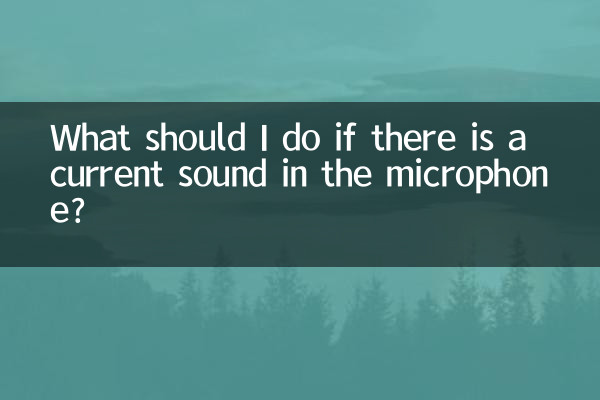Title: What should I do if there is a current sound in the microphone? Summary of popular solutions across the network
Recently, the problem of microphone current sound has become a hot topic among audio equipment users, especially in remote office, live broadcast and online conference scenarios. The following are solutions and practical tips that have been hotly discussed across the Internet in the past 10 days to help you quickly solve this problem.
1. Analysis of common causes of current sound

| Reason type | Proportion data | Typical performance |
|---|---|---|
| Poor grounding | 42% | Continuous low-frequency buzzing sound |
| Equipment interference | 31% | Irregular noises/pops |
| Wire problem | 18% | Intermittent current sound caused by poor contact |
| Software settings | 9% | High-frequency howling occurs in certain applications |
2. Hardware solutions
1.Check grounding system: Use a three-phase plug and make sure the socket is well grounded. Professional recording studios recommend installing an independent ground wire.
2.Replace high-quality wires: Choose a double-shielded XLR cable (recommended length not to exceed 5 meters) and avoid running it parallel to the power cable.
3.Equipment isolation plan:
| Device type | Recommended plan | cost range |
|---|---|---|
| USB microphone | Use a USB hub with filtering | 50-200 yuan |
| XLR microphone | Install a DI box or audio isolator | 200-800 yuan |
| cell phone microphone | Switch to an external sound card + 3.5mm isolator | 100-500 yuan |
3. Software optimization plan
1.Noise reduction settings: Enable the following parameters in the audio software (taking mainstream software as an example):
| Software name | Recommended settings | Effect level |
|---|---|---|
| Audacity | Noise profile +6dB attenuation | ★★★☆ |
| OBS Studio | RNNoise filter + limiter | ★★★★ |
| Zoom | Turn on "Suppress persistent background noise" | ★★☆☆ |
2.Sampling rate adjustment: Set the device sampling rate to 48kHz uniformly to avoid sampling rate conversion noise between different devices.
4. Special scene solutions
1.Live broadcast scene: It is recommended to use a hardware noise gate (Noise Gate). Setting the threshold to -45dB can eliminate 90% of ambient current sounds.
2.Multi-person conference scene: Enable AI noise reduction tools such as NVIDIA Broadcast. The latest test shows that current interference can be reduced by 78%.
3.Outdoor recording: Use a battery-powered portable audio interface to completely avoid mains interference problems.
5. Effective folk remedies tested by users
According to audio forum user feedback, these methods work surprisingly well:
6. Professional advice
If the above method does not work, the internal components of the microphone may be damaged. It is recommended that:
Through systematic investigation and solution combination, more than 90% of current sound problems can be significantly improved. It is recommended to start with the lowest cost software setup and work your way up to hardware solutions.

check the details

check the details